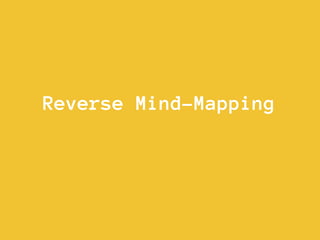
Reverse Mind-Mapping
- 2. Traditional mind-maps kept getting cluttered since the span of the problem was very vast. Also, mind-maps work better for me on paper than on a computer
- 3. This is the direction of a traditional mind-map When the problem is big, it branches out too much making it impossible to make visual association
- 4. The problem can be broken to smaller sub-problems Lesser clutter at each individual brainstorm Solutions filter down as you storm the problems
- 5. I divided the problem into 4 sub-problems 1. Getting to know you 2. Paying attention 3. Framing & Reframing 4. Connect & Combine
- 6. Getting to Know you: The solution is aimed at all people irrespective of their profession or culture, so we need to find what's common among all of us. Also, other mammals like pets around us tend to sleep without any fuss. So, we need to first explore what's common among us all mammals to find what we are doing wrong.
- 7. Are you paying Attention: The results from "Getting to know you" are sent to "Are you paying attention" module.
- 9. Now Go Crazy !!!!
- 14. The End Sorry, its a lot of work getting all the solutions from paper to computer